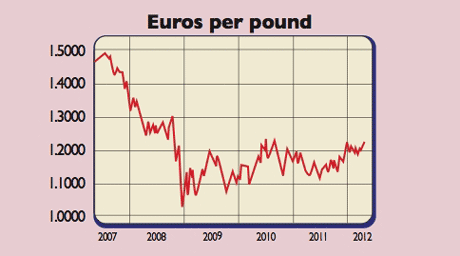The pound has had the best start to the year of all the major currencies. In trade-weighted terms against a basket of major trading partners' currencies it has now hit its highest level since August 2009. A 3% rise against the euro has helped it to a 20-month high of 1.22 against the single currency. Against the greenback, sterling is at a six-month high.
So what's going on? As so often in the forex market, this is a case of the popular currency "winning the least ugly competition", says David Oakley in the Financial Times. Relative growth prospects are one issue. The first-quarter GDP figures were a disappointment. But the tone of more up-to-date surveys has improved, with March's retail sales and employment data stronger than expected.
The minutes from the latest Bank of England Monetary Policy Committee (MPC) meeting also suggested that the chances of there being further quantitative easing (QE, or money printing) are falling. In particular, the news that MPC member Adam Posen had ceased his regular calls for more money printing helped boost the pound. As Ian Campbell says on Breakingviews, "readily printed pounds tend to be cheaper pounds". The latest uptick in inflation has also made the MPC less keen on more QE.
MoneyWeek
Subscribe to MoneyWeek today and get your first six magazine issues absolutely FREE

Sign up to Money Morning
Don't miss the latest investment and personal finances news, market analysis, plus money-saving tips with our free twice-daily newsletter
Don't miss the latest investment and personal finances news, market analysis, plus money-saving tips with our free twice-daily newsletter

Meanwhile, the eurozone crisis has worsened, with Spain looking at risk of default and political ructions in France and the Netherlands threatening to complicate matters further. The latest surveys also point to a deepening recession in Europe; many economists had been hoping for a modest pick-up. American data suggest that growth has cooled again in recent weeks, while Japan continues to struggle.
So where to now for sterling? The outlook against currencies other than the euro remains murky. As Campbell notes, "in another severe leg of the euro crisis, investors are more likely to clutch at dollars than pounds". The same may apply to other liquid currencies, such as the yen. Similarly, a risk-on' environment may lift commodity currencies more than sterling.
However, given the prospect of further political and economic turmoil on the continent, the pound has further upside against the euro. Morgan Stanley reckons the pound could reach €1.26 in six months. Holidaymakers and property owners on the continent, says Ali Hussain in The Sunday Times, may want to wait a bit before buying euros.
Get the latest financial news, insights and expert analysis from our award-winning MoneyWeek team, to help you understand what really matters when it comes to your finances.
MoneyWeek is written by a team of experienced and award-winning journalists, plus expert columnists. As well as daily digital news and features, MoneyWeek also publishes a weekly magazine, covering investing and personal finance. From share tips, pensions, gold to practical investment tips - we provide a round-up to help you make money and keep it.
-
 The most influential people of 2025
The most influential people of 2025Here are the most influential people of 2025, from New York's mayor-elect Zohran Mamdani to Japan’s Iron Lady Sanae Takaichi
-
 Millions of parents are missing out on up to £720 a year in extra pension cash – are you affected?
Millions of parents are missing out on up to £720 a year in extra pension cash – are you affected?A mum who narrowly missed out on the pension boost said she “never knew the government rule existed” and wants other parents to use it

